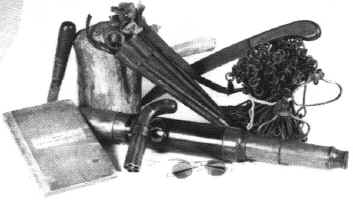 Article taken from "Backsights"
Magazine published by Surveyors Historical Society
Article taken from "Backsights"
Magazine published by Surveyors Historical Society |
THE
A. BROWN ARTIFACTS
by Dale Beeks
 An interesting collection has recently
surfaced consisting of a chest of tools, personal effects and instruments once
belonging to a New England surveyor by the name of A. Brown. No information has
surfaced regarding A. Brown’s surveying activities, however, his inventory
suggests that he was active in the Hudson River Valley during the late 18th-
until sometime during the mid-19th century. An interesting collection has recently
surfaced consisting of a chest of tools, personal effects and instruments once
belonging to a New England surveyor by the name of A. Brown. No information has
surfaced regarding A. Brown’s surveying activities, however, his inventory
suggests that he was active in the Hudson River Valley during the late 18th-
until sometime during the mid-19th century.
Clues as to A. Brown’s
surveying-related activities derive from many of his objects. His surveying and
optical instruments include: a vernier compass signed, "Henry Gattey, New
York", a large spyglass signed, "Benjn Pike & Son New York, Day or
Night", and an octant signed, "Spencer Barrett & Son" with a
trade label within the case of "Michael Rupp....New York".
Signed measuring devices within the
collection include: an open sight bubble level signed, "O. Hanks Patent
1847, M. Watkins & Son MFG Bristol CT", and an 18th century slide rule
signed, "George Catlin Hartford, Caldwell and Colt".
Other maker-signed objects are: two
sets of spectacles, one signed, Bolles & Day Hartford" and the other,
"Wise Brooklyn 5 Pebbles 14K", a cylindrical wooden box with a paper
label marked, "John H. Stevens. American Patent Friction
Match....NY...Boston", a pepperbox type revolver signed, "Allen &
Therber, Allen Patent 1845 Worcester", and a book, Art Without Science,
or, Mensuration, Surveying and Engineering ... by Amos Eaton, 2nd edition,
1830, published in Albany New York.
Dates of manufacturer’s activities
may be applied to many of these signed objects. Henry Gattey (maker of the
vernier compass) was active from approximately 1797 through 1827. (Gattey is
listed from 1800 to 1804 at 205 Water Street NY). Michael Rupp, whose label is
within the case of the English-made octant, is listed from 1829-1844. The Benjn
Pike & Son spyglass dates from 1831-41.
Other tools within the chest include: a
handmade mallet, saw, hatchet, knife, plumb-bob, 4-pole chain and chaining pins.
Additional personal items include: sun spectacles, soap and tin box, small
mirror, pocket knife, ink and pen holder, a match safe, and a ˝ plate
daguerreotype photograph of Mr. Brown.
The geographic locations of these
various makers suggest Brown’s work activities included the Hudson River
Valley from New York City to Albany/Troy new York and include Bristol/Hartford,
CT and Worcester MA. It appears he shopped for his instruments and optical goods
in New York City, and a gun made in Hartford may have afforded him protection
while in the field. His calculations were made with a wantage slide rule which
was originally made for volume computations of barrels of spirits, but would
suffice for necessary trigonometric computations.
The textbook by Amos Eaton, Senior
Professor from Rensselaer School (first published in 1800), discusses surveys
made by him in the region. The book further explains various aspects of
surveying, including: "magnetizing the needle, correcting chain, the proper
use of stakes and tallies, field book, pens and ink and even the proper names of
assistants (‘fore chain-bearer, baggage man and flag man’)". An
interesting account by Eaton relates how..."I found my staff was too
slender to keep the compass steady"...and how he "directed the axeman
to fit a stiffer one into the iron socket"... which took the axeman
"...but thirteen minutes of time...". Eaton continues... "A
tripod will never be used in the field by an experienced surveyor". Texts
such as Eaton’s helped shape the standard field practices of surveyors such as
A. Brown.
While additional information on A.
Brown would help better understand this unique as semblage, collections of
tools-of-the-trade are quite extraordinary. Where they do exist, these
collections have the potential to give new insights into the lives of specific
tradesmen. This collection is no exception; it is an inspiring collection of
objects which help give insight into the activities of an early New England
surveyor.
|
